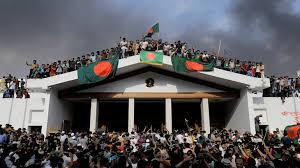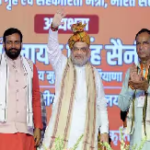Harsh V Pant
An interim government led by Nobel laureate Muhammad Yunus has taken charge of a fractured Bangladesh after a meeting between President Mohammed Shahabuddin, military leaders and student activists. Promising to “uphold, support and protect the constitution”, Yunus has called for the restoration of law and order as his government faces the reality of the withering away of state apparatus. Sheikh Hasina is gone, but the real challenge begins now. A new reality confronts the people of Bangladesh. There is a new sense of optimism, but it is embedded in a deeply divided society and polity.
From Certainty To Doubts
Prime Minister Narendra Modi has already extended his best wishes to Professor Muhammad Yunus on his new role and has expressed hope for a swift return to normalcy, emphasising the importance of ensuring the safety and protection of Hindus and all minority communities. For India, challenges abound as Hasina, its long-standing partner, had to depart in ignominy. The certainty of the last 15 years has given way to a sense of the unknown. New Delhi had invested in its partnership with Dhaka confident that the Hasina dispensation would not let it down. As a result, a bilateral partnership that followed could not only resolve some of the most testing challenges but it also emerged as an anchor in the wider Bay of Bengal.
However, Hasina’s tendency to centralise decision-making and marginalise the opposition managed to limit Bangladesh’s evolution into a mature democracy. As Hasina drifted towards authoritarianism, New Delhi’s options got further curtailed. Now, India has to ensure that it manages to build ties with the new leadership in Dhaka.
Building New Relationships
After signalling clearly that India will stand by its allies by getting Hasina out of Bangladesh, the next step is to engage the emerging political stakeholders in Bangladesh. This is needed not only for the long-term stability of Delhi-Dhaka ties but also for managing the immediate challenges of protecting minorities within Bangladesh and stabilising the highly volatile border area.
India shares a largely porous 4,096 km of land border with Bangladesh. This border runs along the states of West Bengal, Assam, Meghalaya, Tripura and Mizoram, areas once frequented by insurgent groups. However, under Hasina’s leadership, the border remained relatively calm, as these groups have been prevented from finding refuge in Bangladesh. There are already reports of turbulence and New Delhi has asked its border security forces to be on high alert. With India facing serious challenges along its borders with Pakistan and China, the new reality with Bangladesh bodes ill for national security.
Extremism Remains A Concern
The rise of Islamist extremism in Bangladesh is another challenge that New Delhi will be closely watching. Before Hasina, various extremist groups were flourishing under the patronage of the Bangladesh Nationalist Party (BNP) government. Many of these groups, such as the Ansarullah Bangla Team, the Hizb ut-Tahrir, and the Jamaat-ul-Mujahideen Bangladesh (JMB), have had links to various terrorist outfits based in Pakistan as well as to the Inter-Services Intelligence (ISI). The present situation in Bangladesh opens up new possibilities for reviving these links. Jamaat-e-Islami is widely viewed as a key instigator of the recent riots that toppled Hasina. The Hasina government had banned it in 2013, but today it has re-emerged as a major political force.
The systematic targeting of Hindus also poses a challenge to India-Bangladesh ties as it will harden the mood in New Delhi against any engagement with Dhaka. Domestic politics in both nations will have to maturely handle rapidly deteriorating perceptions about each other.
Balancing Other Neighbours
In recent years, the two South Asian neighbours have been focused on enhancing trade and connectivity so as to turn the Bay of Bengal into a hub of regional economic framework. Political trust is a crucial variable in shaping today’s economic partnerships. Unless the new government in Dhaka is able to generate trust in Delhi, it won’t be possible to revive the old paradigm of bilateral economic engagement. This would be a loss for India as its ability to make its northeastern region economically dynamic is premised on strong India-Bangladesh economic ties. But it would also be a loss for Bangladesh, which has effectively leveraged its two regional economic partners – India and China – to reinvigorate its economic potential.
New Delhi would also be wary of Pakistan and China trying to fish in the troubled waters of the Bay of Bengal. The logic of geography dictates that both Delhi and Dhaka will have to engage each other to nurture their aspiration. It is easy to forget how much despair there was about India-Bangladesh ties before Hasina had come to power. But at a time when India sees itself as a leading global power, it cannot afford to ignore the challenges emanating from its most important partner in South Asia.



